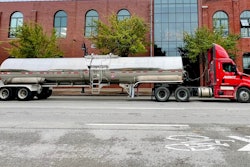The American Trucking Associations today, Nov. 1, urged Congress to help the trucking industry keep drug and alcohol abusers off the road by supporting efforts to enhance drug and alcohol testing for the nation’s 3.4 million truck drivers.
ATA’s request came as the Government Accountability Office — the investigative arm of Congress — issued a report today on a probe that determined that it was surprisingly easy for drivers to cheat on random drug tests.
Testifying on behalf of ATA before the Subcommittee on Highways and Transit of the House Transportation and Infrastructure Committee, Greer Woodruff, senior vice president of corporate safety and security for J.B. Hunt Transport Services, made five recommendations for improving drug and alcohol testing programs for commercial motor vehicle drivers.
“Trucking has worked diligently to eradicate drug and alcohol abuse from its work force,” said Bill Graves, ATA president and chief executive officer. “And we’ve made great strides in recent years. But now, trucking is looking to the government for additional help.”
ATA urged Congress to authorize and fund a centralized clearinghouse for positive drug and alcohol testing results of commercial drivers to ensure that motor carrier employers are aware of previous positive test results during the hiring process. The association also asked Congress to encourage the Department of Transportation to implement an incentive-based random testing rate requirement and focus on motor carriers with above-average positive test results.
Recommendations further included banning the manufacture, sale and distribution of products that help drivers evade drug tests and penalizing those who use them; directing the Substance Abuse and Mental Health Services Administration and DOT to initiate a rulemaking that allows the testing of hair as an alternative to urine; and improving oversight of specimen collection facilities and practices.
ATA says the percentage of drug abuse among the driver population has remained about 2 percent since required testing began in 1995. According to government reports, drug abuse in the trucking industry, as measured by a percentage of positive test results, is less than half of that found in the general work force.
FMCSA data indicate that 1.3 to 2.8 percent of commercial drivers randomly tested between 1994 and 2005 tested positive for illegal drugs. However, in two 72-hour sessions this year, Oregon roadside inspectors collected 500 urine samples from commercial drivers – mostly heavy-truck drivers – and found the locations averaged nearly 9 and 10 percent for positive results. The Oregon samples had been tested anonymously, so follow-up was impossible.
There could be other explanations for the rates, such as false positives and differences among state testing methods.
In February, the Subcommittee on Highways and Transit heard a Minneapolis television station report that four of the five local DOT drug test collection sites allowed ways to cheat on urine tests. The committee asked the GAO to investigate undercover.
Investigators invented two trucking companies, produced bogus driver’s licenses and then posed as truckers to test 24 collection sites nationwide. The GAO also interviewed all parties involved in testing, from carrier representatives to federal officials, and analyzed regulations and data.
Investigators used bogus driver’s licenses to gain access to all 24 sites investigated, showing that a drug user could send someone else to take a drug test using fake identification. Twenty-two of the 24 selected sites did not follow the remaining protocols adequately; for example, 75 percent of sites tested didn’t restrict access to items that could be used to change the specimen, such as running water, soap or air freshener.
The GAO found a significant lack of compliance among carriers, particularly small carriers and self-employed truckers. More than half of carriers with operating authority are single-truck owner-operators. While they still have to implement a drug and alcohol testing program, they usually use a third-party administrator. That administrator doesn’t have the authority to enforce regulations if drug use is indicated.
According to the National Transportation Safety Board, owner-operators “are in the precarious position of overseeing their own substance abuse program.” Drug testing protocol violations are noted in more than 40 percent of FMCSA’s safety audits conducted since 2003 of carriers that have recently started operations, and more than 70 percent of the compliance reviews conducted on carriers in the industry since 2001.
FMCSA’s oversight activities are limited in quantity and scope. Safety audits targeted at new entrants began in 2003 and do not affect carriers in business before then. Such companies can be covered in compliance reviews, but these reviews occur at only about 2 percent of carriers a year, according to FMCSA. In addition, the agency’s oversight does not address compliance by service agents unless there are allegations or complaints.
Even when FMCSA is able to ensure that carriers and others are in compliance with drug testing requirements, the urine test can be subverted. Drug masking products such as adulterants work well and destroy the evidence of their presence. Investigators demonstrated that such products easily could be brought to the sites undetected.
In 2005, the GAO testified that 400 products were marketed to mislead drug tests. Furthermore, the required test covers only five drug categories, and it may provide a clean result if a person has not used any of these drugs recently. The GAO will continue examining these recommendations, some of which were proposed by carriers and industry representatives:
Rep. Jim Oberstar, D-Minn., chairman of the House Transportation and Infrastructure Committee, who asked GAO to investigate, said the report was “frankly astonishing and shocking and dismaying. You can manipulate the tests, you can mask substance abuse and go undetected on the roadways.”
Oberstar, who held today’s congressional hearing, said the drug-testing system was broken and was placing other drivers in danger. “It fails, it is not sufficient, it is not protecting the public interest,” he said.










